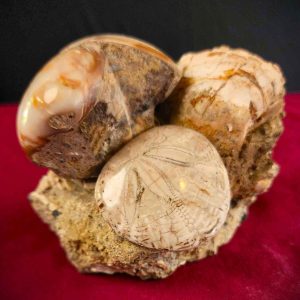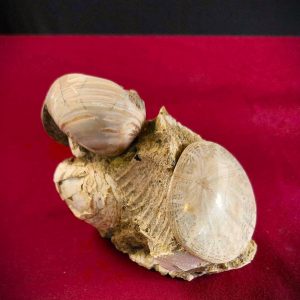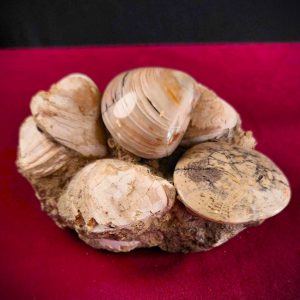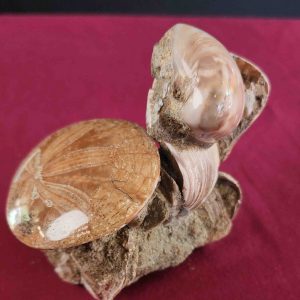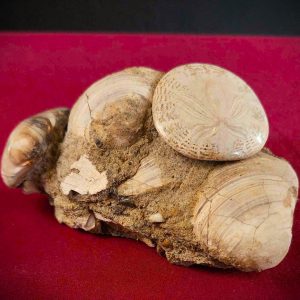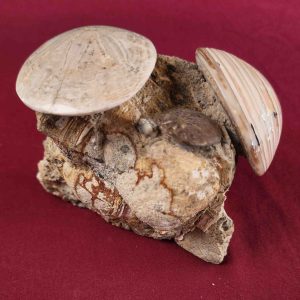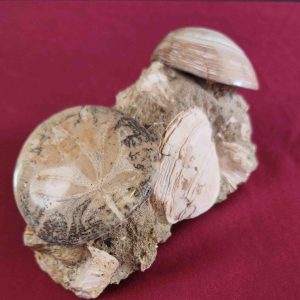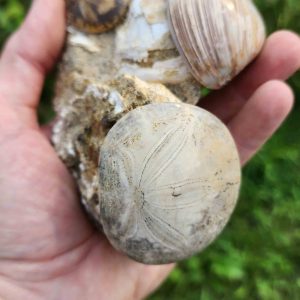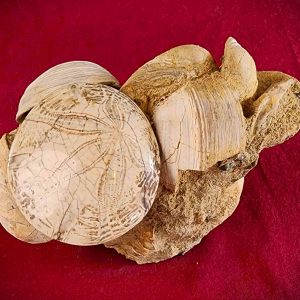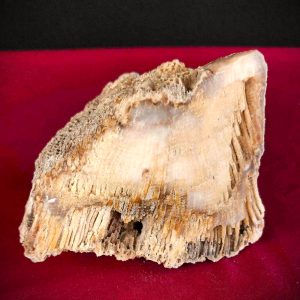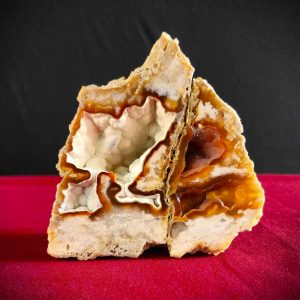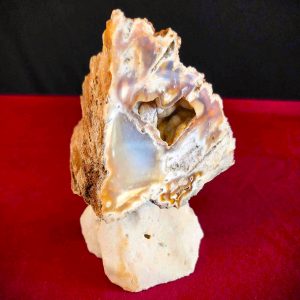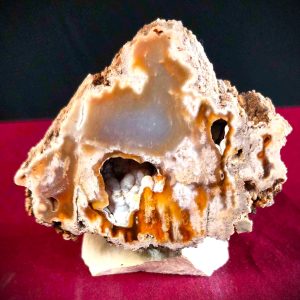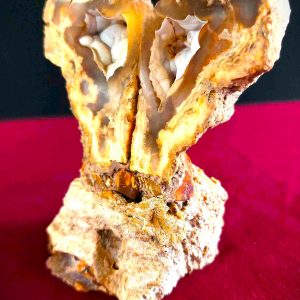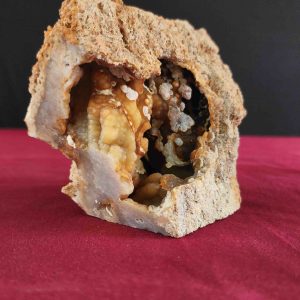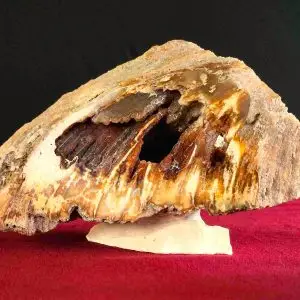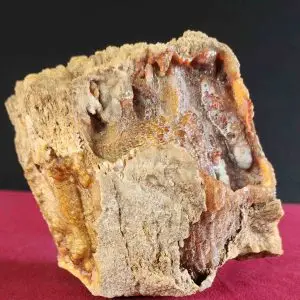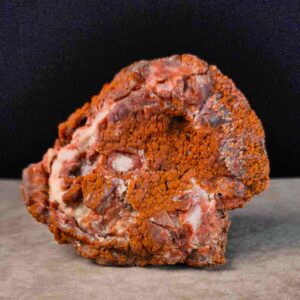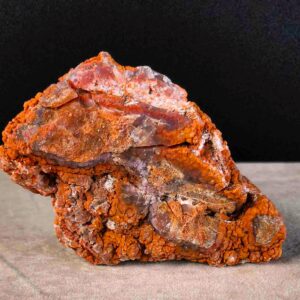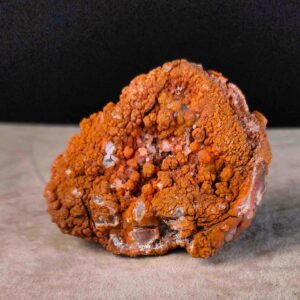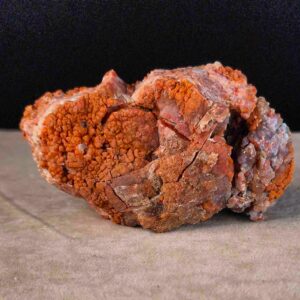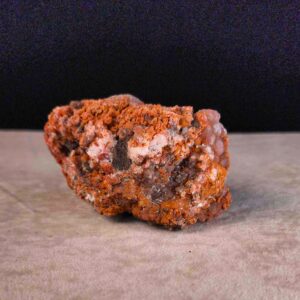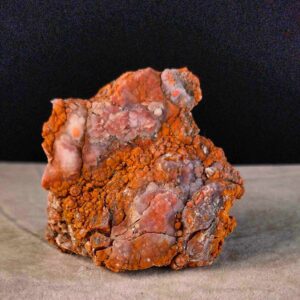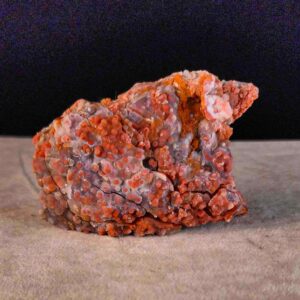Fossils
Agatized Algae?
Now that’s a phrase you will not hear anywhere else. Why? Because no one else has ever found these fossils! Here are some of the strangest and most beautiful fossils we’ve ever excavated. We discovered this small site in 2008 by complete accident in the remote deserts of southern Utah while on a canyoneering expedition in the wild. And what a surprise it was! When Vern discovered a few pieces of this material in the bottom of one of the slot canyons we were exploring, we originally thought they were dinosaur coprolites. But further research revealed they are actually colonies of aquatic algae – a discovery that turns out is much rarer. The original algal groups formed knobby, three-dimensional elliptical and spherical nodules on the floor of a shallow sea during Jurassic time, about 165 million years ago. Take a look at the B&W photo here – It shows living algal balls in the bottom of a lake in Ontario, Canada (we took that shot underwater in 2015). Next to it, In Julie’s hand, are two living specimens algal balls from that location. Notice the surface texture of the living forms – they are “bubbly” just like the fossil specimens we’re offering here.
How They Formed
These rare and unique fossils formed when rapidly-accumulating sediment buried the living algal colonies , which then dissolved away and were replaced by quartz.. As the layers piled up, the pressure crushed and distorted most of the spherical algal forms, collapsing their tops downward. In some cases where the crushed ball is still well preserved, there are relic fractures and cracks from the original crushed algae evident. The result is agatized forms with a variety of textures and colors. There’s nothing like these fossils anywhere! As you can see in the site photos, due to the fragility of the original forms, the layers in which these occur yield mostly just fragmentary specimens. Only rarely are the entire algal nodules preserved. NOTE: While some of the agate could lend itself to cutting and polishing into jewelry, we prefer to keep these unique fossil specimens intact.
-
Fossil Sand Dollar and Clam (KH9)
These well-preserved clams and sand dollars lived in a shallow sea that covered the San Joaquin Valley for millions of years. During storms the animals became buried in sediments which preserved the shells. Under heat and pressure, the shells altered into calcite, yet preserved their fine detail. Later, due to movement of the nearby San Andreas fault, the whole area was uplifted, becoming the Kettleman Hills. The Hills became famous for its oil in the 1920s. But the oil has since played out and the land is returning to its former native environment. We’ve polished the primary shells to show their beauty and detail. Iron and petroleum color the shells. We have spent years mapping the Hills and are the only people who know where to find these unique fossils.
Notes specific to this specimen: One large polished sand dollar with two great polished clams. Matrix piece that has a flat bottom so it stands nicely.
SIZE: 4″x 2″x 3″
NAME: Psuedocardium & Dendraster
AGE: Pliocene 4 million years
UNIT: Etchegoin Formation
SITE: Kettleman Hills, CaliforniaDocuments: This authentic fossil specimen comes with a Certificate of Authenticity and Origin. In addition, an attractive and informative display card accompanies the specimen.
$395.00 -
Fossil Sand Dollar and Clam (KH8)
These well-preserved clams and sand dollars lived in a shallow sea that covered the San Joaquin Valley for millions of years. During storms the animals became buried in sediments which preserved the shells. Under heat and pressure, the shells altered into calcite, yet preserved their fine detail. Later, due to movement of the nearby San Andreas fault, the whole area was uplifted, becoming the Kettleman Hills. The Hills became famous for its oil in the 1920s. But the oil has since played out and the land is returning to its former native environment. We’ve polished the primary shells to show their beauty and detail. Iron and petroleum color the shells. We have spent years mapping the Hills and are the only people who know where to find these unique fossils.
NOTE: One large polished sand dollar with a great polished clam.An attractive and informative display card accompanies the specimen.
SIZE: 4″x 2″x 3″
* Shipping includes packaging, insurance, and ground transport in the continental US. Inquire about shipping outside US.
$88.00 -
Fossil Sand Dollar and Clam (KH7)
These well-preserved clams and sand dollars lived in a shallow sea that covered the San Joaquin Valley for millions of years. During storms the animals became buried in sediments which preserved the shells. Under heat and pressure, the shells altered into calcite, yet preserved their fine detail. Later, due to movement of the nearby San Andreas fault, the whole area was uplifted, becoming the Kettleman Hills. The Hills became famous for its oil in the 1920s. But the oil has since played out and the land is returning to its former native environment. We’ve polished the primary shells to show their beauty and detail. Iron and petroleum color the shells. We have spent years mapping the Hills and are the only people who know where to find these unique fossils.
NOTE: Excellent group of clams with one nice large polished sand dollar. An attractive and informative display card accompanies the specimen.
SIZE: 5″x 3″x 3″
* Shipping includes packaging, insurance, and ground transport in the continental US. Inquire about shipping outside US.
$96.00 -
Fossil Sand Dollar and Clam (KH6)
These well-preserved clams and sand dollars lived in a shallow sea that covered the San Joaquin Valley for millions of years. During storms the animals became buried in sediments which preserved the shells. Under heat and pressure, the shells altered into calcite, yet preserved their fine detail. Later, due to movement of the nearby San Andreas fault, the whole area was uplifted, becoming the Kettleman Hills. The Hills became famous for its oil in the 1920s. But the oil has since played out and the land is returning to its former native environment. We’ve polished the primary shells to show their beauty and detail. Iron and petroleum color the shells. We have spent years mapping the Hills and are the only people who know where to find these unique fossils.
Notes specific to this specimen: Exquisite large brown polished sand dollar with two great polished clams and some unpolished clams beside them. This is a matrix piece that has a flat bottom so it stands up nicely.
SIZE: 4″x 3″x 3″
NAME: Psuedocardium & Dendraster
AGE: Pliocene 4 million years
UNIT: Etchegoin Formation
SITE: Kettleman Hills, CaliforniaDocuments: This authentic fossil specimen comes with a Certificate of Authenticity and Origin. In addition, an attractive and informative display card accompanies the specimen.
$650.00 -
Fossil Sand Dollar and Clam (KH5)
These well-preserved clams and sand dollars lived in a shallow sea that covered the San Joaquin Valley for millions of years. During storms the animals became buried in sediments which preserved the shells. Under heat and pressure, the shells altered into calcite, yet preserved their fine detail. Later, due to movement of the nearby San Andreas fault, the whole area was uplifted, becoming the Kettleman Hills. The Hills became famous for its oil in the 1920s. But the oil has since played out and the land is returning to its former native environment. We’ve polished the primary shells to show their beauty and detail. Iron and petroleum color the shells. We have spent years mapping the Hills and are the only people who know where to find these unique fossils.
NOTE: One large polished sand dollar with a great polished clam and some unpolished clams as well. An attractive and informative display card accompanies the specimen.
SIZE: 5″x 2″x 3″
* Shipping includes packaging, insurance, and ground transport in the continental US. Inquire about shipping outside US.
$84.00 -
Fossil Sand Dollar and Clam (KH4)
These well-preserved clams and sand dollars lived in a shallow sea that covered the San Joaquin Valley for millions of years. During storms the animals became buried in sediments which preserved the shells. Under heat and pressure, the shells altered into calcite, yet preserved their fine detail. Later, due to movement of the nearby San Andreas fault, the whole area was uplifted, becoming the Kettleman Hills. The Hills became famous for its oil in the 1920s. But the oil has since played out and the land is returning to its former native environment. We’ve polished the primary shells to show their beauty and detail. Iron and petroleum color the shells. We have spent years mapping the Hills and are the only people who know where to find these unique fossils.
Notes specific to this specimen: Beautiful and showy matrix piece with flat bottom so it stands nicely. This specimen has one large polished sand dollar and one infant sand dollar along with a great polished clam.
SIZE: 4″x 3″x 3″
NAME: Psuedocardium & Dendraster
AGE: Pliocene 4 million years
UNIT: Etchegoin Formation
SITE: Kettleman Hills, CaliforniaDocuments: This authentic fossil specimen comes with a Certificate of Authenticity and Origin. In addition, an attractive and informative display card accompanies the specimen.
$460.00 -
Fossil Sand Dollar and Clam (KH3)
These well-preserved clams and sand dollars lived in a shallow sea that covered the San Joaquin Valley for millions of years. During storms the animals became buried in sediments which preserved the shells. Under heat and pressure, the shells altered into calcite, yet preserved their fine detail. Later, due to movement of the nearby San Andreas fault, the whole area was uplifted, becoming the Kettleman Hills. The Hills became famous for its oil in the 1920s. But the oil has since played out and the land is returning to its former native environment. We’ve polished the primary shells to show their beauty and detail. Iron and petroleum color the shells. We have spent years mapping the Hills and are the only people who know where to find these unique fossils.
NOTE: One large polished sand dollar with a great polished clam.An attractive and informative display card accompanies the specimen.
SIZE: 4″x 3″x 3″
* Shipping includes packaging, insurance, and ground transport in the continental US. Inquire about shipping outside US.
$84.00 -
Fossil Sand Dollar and Clam (KH2)
These well-preserved clams and sand dollars lived in a shallow sea that covered the San Joaquin Valley for millions of years. During storms the animals became buried in sediments which preserved the shells. Under heat and pressure, the shells altered into calcite, yet preserved their fine detail. Later, due to movement of the nearby San Andreas fault, the whole area was uplifted, becoming the Kettleman Hills. The Hills became famous for its oil in the 1920s. But the oil has since played out and the land is returning to its former native environment. We’ve polished the primary shells to show their beauty and detail. Iron and petroleum color the shells. We have spent years mapping the Hills and are the only people who know where to find these unique fossils.
Notes specific to this specimen: Matrix piece that has a flat bottom so it stands nicely. This specimen has one large and one infant sand dollar with a nice polished clam that has great colors.
SIZE: 5″x 3″x 3″
NAME: Psuedocardium & Dendraster
AGE: Pliocene Epoch – 4 million years
UNIT: Etchegoin Formation
SITE: Kettleman Hills, California
DATE: 2023Documents: This authentic fossil specimen comes with a Certificate of Authenticity and Origin. In addition, an attractive and informative display card accompanies the specimen.
$460.00 -
Fossil Sand Dollar and Clam (KH1)
These well-preserved clams and sand dollars lived in a shallow sea that covered the San Joaquin Valley for millions of years. During storms the animals became buried in sediments which preserved the shells. Under heat and pressure, the shells altered into calcite, yet preserved their fine detail. Later, due to movement of the nearby San Andreas fault, the whole area was uplifted, becoming the Kettleman Hills. The Hills became famous for its oil in the 1920s. But the oil has since played out and the land is returning to its former native environment. We’ve polished the primary shells to show their beauty and detail. Iron and petroleum color the shells. We have spent years mapping the Hills and are the only people who know where to find these unique fossils.
NOTE: One superb large sand dollar and several clams. An attractive and informative display card accompanies the specimen.
SIZE: 6″x 3″x 4″
* Shipping includes packaging, insurance, and ground transport in the continental US. Inquire about shipping outside US.
$84.00 -
Agatized Coral (AC10)
These unique fossils are preserved corals that lived in large reef systems in Florida and Georgia about 34 million years ago. After the corals died, they were buried in deep sediments where the original corallite structures began to erode away. In some cases, this resulted in hollow cavities that were then coated in translucent agate, forming carnelian geodes. In others, the agate replaced the solids and retained images of the coral structures. We are the oldest and most experienced source for these unique fossils. Our teams have been SCUBA diving for these corals since the mid 1970s.
NOTE: Unusual piece with preserved coral structures. Cut and polished face. An attractive and informative display card accompanies the specimen.
SIZE: 6″x 5″x 5″
* Shipping includes packaging, insurance, and ground transport in the continental US. Inquire about shipping outside US.
$46.00Agatized Coral (AC10)
$46.00 -
Agatized Coral (AC9)
These unique fossils are preserved corals that lived in large reef systems in Florida and Georgia about 34 million years ago. After the corals died, they were buried in deep sediments where the original corallite structures began to erode away. In some cases, this resulted in hollow cavities that were then coated in translucent agate, forming carnelian geodes. In others, the agate replaced the solids and retained images of the coral structures. We are the oldest and most experienced source for these unique fossils. Our teams have been SCUBA diving for these corals since the mid 1970s.
NOTE: Beautiful multi-chambered piece cut and polished face. An attractive and informative display card accompanies the specimen.
SIZE: 5″x 3″x 5″
* Shipping includes packaging, insurance, and ground transport in the continental US. Inquire about shipping outside US.
$88.00Agatized Coral (AC9)
$88.00 -
Agatized Coral (AC8)
These unique fossils are preserved corals that lived in large reef systems in Florida and Georgia about 34 million years ago. After the corals died, they were buried in deep sediments where the original corallite structures began to erode away. In some cases, this resulted in hollow cavities that were then coated in translucent agate, forming carnelian geodes. In others, the agate replaced the solids and retained images of the coral structures. We are the oldest and most experienced source for these unique fossils. Our teams have been SCUBA diving for these corals since the mid 1970s.
NOTE: A very nice multi-chambered piece cut and polished face. This specimen is mounted on native Suwanee Limestone – which is the matrix material these specimens weather out of. No other preparator mounts these speciemns on their native stone. An attractive and informative display card accompanies the specimen.
SIZE: 4″x 4″x 5″
* Shipping includes packaging, insurance, and ground transport in the continental US. Inquire about shipping outside US.
$56.00Agatized Coral (AC8)
$56.00 -
Agatized Coral (AC7)
These unique fossils are preserved corals that lived in large reef systems in Florida and Georgia about 34 million years ago. After the corals died, they were buried in deep sediments where the original corallite structures began to erode away. In some cases, this resulted in hollow cavities that were then coated in translucent agate, forming carnelian geodes. In others, the agate replaced the solids and retained images of the coral structures. We are the oldest and most experienced source for these unique fossils. Our teams have been SCUBA diving for these corals since the mid 1970s.
NOTE: A very nice multi-chambered piece cut and polished face. This specimen is mounted on native Suwanee Limestone – which is the matrix material these specimens weather out of. No other preparator mounts these speciemns on their native stone. An attractive and informative display card accompanies the specimen.
SIZE: 4″x 4″x 5″
* Shipping includes packaging, insurance, and ground transport in the continental US. Inquire about shipping outside US.
$56.00Agatized Coral (AC7)
$56.00 -
Agatized Coral (AC6)
These unique fossils are preserved corals that lived in large reef systems in Florida and Georgia about 34 million years ago. After the corals died, they were buried in deep sediments where the original corallite structures began to erode away. In some cases, this resulted in hollow cavities that were then coated in translucent agate, forming carnelian geodes. In others, the agate replaced the solids and retained images of the coral structures. We are the oldest and most experienced source for these unique fossils. Our teams have been SCUBA diving for these corals since the mid 1970s.
NOTE: This is a very nice cut and polished pair, mounted on another agatized coral that has a flat bottom. An attractive and informative display card accompanies the specimen.
SIZE: 4″x 4″x 6″
* Shipping includes packaging, insurance, and ground transport in the continental US. Inquire about shipping outside US.
$78.00Agatized Coral (AC6)
$78.00 -
Agatized Coral (AC5)
These unique fossils are preserved corals that lived in large reef systems in Florida and Georgia about 34 million years ago. After the corals died, they were buried in deep sediments where the original corallite structures began to erode away. In some cases, this resulted in hollow cavities that were then coated in translucent agate, forming carnelian geodes. In others, the agate replaced the solids and retained images of the coral structures. We are the oldest and most experienced source for these unique fossils. Our teams have been SCUBA diving for these corals since the mid 1970s.
NOTE: Corner hollow piece with cut base
SIZE: 4″x 5″x 4″
* Shipping includes packaging, insurance, and ground transport in the continental US. Inquire about shipping outside US.
$36.00Agatized Coral (AC5)
$36.00 -
Agatized Coral (AC4)
These unique fossils are preserved corals that lived in large reef systems in Florida and Georgia about 34 million years ago. After the corals died, they were buried in deep sediments where the original corallite structures began to erode away. In some cases, this resulted in hollow cavities that were then coated in translucent agate, forming carnelian geodes. In others, the agate replaced the solids and retained images of the coral structures. We are the oldest and most experienced source for these unique fossils. Our teams have been SCUBA diving for these corals since the mid 1970s.
Notes specific to this specimen: A very nice multi-chambered piece with a cut and polished carnelian agate face. It also has a natural opening on the other end. This specimen is mounted on native Suwanee Limestone – which is the matrix material these specimens weather out of. You won’t see that anywhere else.
SIZE: 8″ x 5″ x 5″
NAME: Several species
AGE: Oligocene Epoch- 34 million years
UNIT: Suwanee Limestone
SITE: Lowndes County, Georgia
DATE: 2021Documentation: This authentic fossil specimen comes with a Certificate of Authenticity and Origin. In addition, an attractive and informative display card accompanies the specimen.
$194.00Agatized Coral (AC4)
$194.00 -
Agatized Coral (AC3)
Notes specific to this specimen: This is an exceptional and exquisite carnelian agate pair with rare fortified agatized cavities and preserved microscopic internal structures. This cut and polished pair is mounted on a pleasing piece of Suwanee Limestone – which is the matrix material these specimens originated from. No other preparator mounts these specimens on their native matrix. Honestly, most people don’t even know how they formed, much less know the association with Suwanee Limestone! You can see how translucent the hollows are – the carnelian agate just glows! Zoom in and look at the lighter colored sections below the hollow and you’ll see that it’s actually lace agate. We’ve never seen this before This is a one-of-a-kind beautiful pair!
SIZE: 9″x 4″x 5″
NAME: Several species
AGE: Oligocene Epoch- 34 million years
UNIT: Suwanee Limestone
SITE: Lowndes County, Georgia
DATE: 2021Documentation: This authentic fossil specimen comes with a Certificate of Authenticity and Origin. In addition, an attractive and informative display card accompanies the specimen.
$645.00Agatized Coral (AC3)
$645.00 -
Agatized Algae (AA2)
A rare, complete nodule. This specimen is a round, deflated sphere with nice bubbly agate skin all over it. One side is concave, the other convex, indicating the orientation of the original colony in the sediments. Can you guess which way it was oriented? Answer – the convex side was up. As the sediments accumulated and the agal ball deteriorated, the top collapsed. The bottom, meanwhile, was supported by the sediments below allowing it to retain its original shape.
Notes specific to this specimen: A rare, complete nodule. This specimen is a round, deflated sphere with nice bubbly agate skin all over it. One side is concave, the other convex, indicating the orientation of the original colony in the sediments. Can you guess which way it was oriented? Answer – the convex side was up. As the sediments accumulated and the agal ball deteriorated, the top collapsed. The bottom, meanwhile, was supported by the sediments below allowing it to retain its original shape.
SIZE: 5″x 4″x 2″
NAME: Various species
AGE: Jurassic Period- 165 million years
UNIT: Curtis Formation
SITE: Emery County, Utah
LOCATION: Blue Crate In flat at bottom
DATE: 2010Documentation: This authentic fossil specimen comes with a Certificate of Authenticity and Origin.
$420.00Agatized Algae (AA2)
$420.00 -
Agatized Algae (AA8)
Notes specific to this specimen: Strange shape with a variety of colors. This is one of the more unusual specimens we’ve seen – it contains relic cracks from the collapse of the original structure and a variety of textures and colors. Which end was up? We cannot tell on this one! Zoom in on the bubbly side – it’s awesome!
SIZE: 5″x 3″x 2″
NAME: Undescribed species
AGE: Jurassic Period- 165 million years
UNIT: Curtis Formation
SITE: Emery County, Utah
DATE: 2010Documentation: This authentic fossil specimen comes with a Certificate of Authenticity and Origin.
$220.00Agatized Algae (AA8)
$220.00 -
Agatized Algae (AA7)
Notes specific to this specimen: Small but complete algal ball – a round specimen with great bubblegum agate skin on the upper (convex) side and a nice multicolored carnelian agate underside (convex).
SIZE: 4″x 3″x 2″
NAME: Undescribed species
AGE: Jurassic Period- 165 million years
UNIT: Curtis Formation
SITE: Emery County, Utah
DATE: 2010Documentation: This authentic fossil specimen comes with a Certificate of Authenticity and Origin.
$185.00Agatized Algae (AA7)
$185.00 -
Agatized Algae (AA6)
Notes specific to this specimen: A nearly complete round algal “egg” that retains some of its 3-D character. Very rare. This one has various sections to it which feature different textures and colors, including a nice blueish agate region which is unusual in these specimens.
SIZE: 4″x 2″x 2″
NAME: Undescribed species
AGE: Jurassic Period- 165 million years
UNIT: Curtis Formation
SITE: Emery County, Utah
DATE: 2010Documentation: This authentic fossil specimen comes with a Certificate of Authenticity and Origin.
$320.00Agatized Algae (AA6)
$320.00 -
Agatized Algae (AA5)
Notes specific to this specimen: This is a piece of a much larger specimen. While it is not complete, the color and texture of this piece is very interesting. It retains some of the original 3-D shape, which is rare in this preservation environment.
SIZE: 5″x 2″x 2″
NAME: Undescribed species
AGE: Jurassic Period- 165 million years
UNIT: Curtis Formation
SITE: Emery County, Utah
DATE: 2010Documentation: This authentic fossil specimen comes with a Certificate of Authenticity and Origin.
$155.00Agatized Algae (AA5)
$155.00 -
Agatized Algae (AA4)
Notes specific to this specimen: A rare, complete nodule. This specimen is a round, deflated sphere with nice bubbly agate skin all over it. One side is concave, the other convex, indicating the orientation of the original colony in the sediments. Can you guess which way it was oriented? Answer – the convex side was up. As the sediments accumulated and the agal ball deteriorated, the top collapsed. The bottom, meanwhile, was supported by the sediments below allowing it to retain its original shape.
SIZE: 4″x 4″x 2″
NAME: Various species
AGE: Jurassic Period- 165 million years
UNIT: Curtis Formation
SITE: Emery County, Utah
DATE: 2010Documentation: This authentic fossil specimen comes with a Certificate of Authenticity and Origin.
$265.00Agatized Algae (AA4)
$265.00 -
Agatized Algae (AA3)
This is a piece of a much larger specimen. While it is not complete, the color and texture of this piece is incredible. Beautiful, multicolored bubblegum agate all over it!
Notes specific to this specimen: This is a piece of a much larger specimen. While it is not complete, the color and texture of this piece is incredible. Beautiful, multicolored bubblegum agate all over it!
SIZE: 4″x 2″x 2″
NAME: Undescribed species
AGE: Jurassic Period- 165 million years
UNIT: Curtis Formation
SITE: Emery County, Utah
DATE: 2010Documentation: This authentic fossil specimen comes with a Certificate of Authenticity and Origin.
$185.00Agatized Algae (AA3)
$185.00

